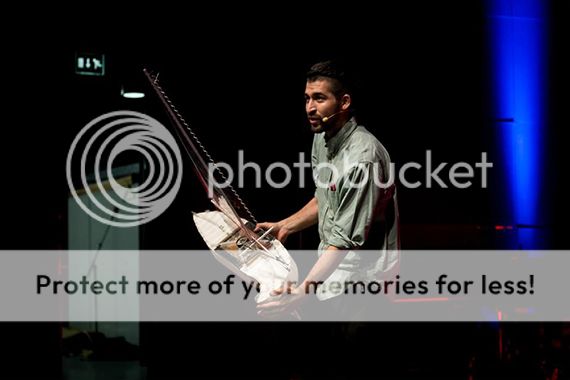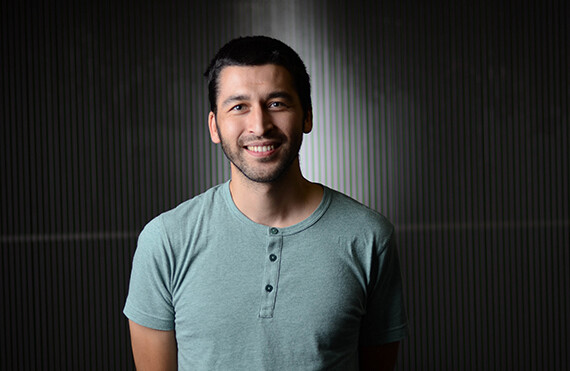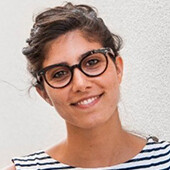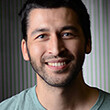I had always thought of interviews as a unidirectional endeavor, where for an hour or so I was given the opportunity to witness and dive into another person's life, goals, struggles, and fears. But an hour into the conversation with Cesar Harada, he turned to me and, genuinely interested, asked: "We've spent more than an hour talking about me. Can you tell me something about you?" Harada's empathy extends from the people around him to the environment. He is an inventor, an environmentalist, and an entrepreneur obsessed with oceans. He is the founder of Protei, an "ocean-cleaning and research open hardware drone." He is imitating nature to solve some of the problems caused by human beings' destructive lifestyles. He is building drones that swim like fish.
IRENE PEDRUELO: You have taught graphic design, studied glass-blowing, assisted several sculptors over the years, been a researcher at MIT [Massachusetts Institute of Technology] SENSEable City Lab, etc. I'm curious to know how you see yourself.
CESAR HARADA: Defining myself is something I would rather not spend time on. I know it sounds pretentious, but I am half Japanese, half French and people always expect I will have an identity crisis. Or when you are looking for a job, and they ask you, "What are you?" and you have to create a package to sell yourself. I believe in the principle of action rather than the principle of being. I believe we are defined by what we do, and I am just focused on doing stuff.
IRENE PEDRUELO: How was Protei born?
CESAR HARADA: I used to work at MIT and I was in charge of a team developing a technology to clean the BP oil spill. I wasn't comfortable with how my lab was operating, so I decided to move to the Gulf of Mexico. I lived there for two years. I started volunteering for a non-profit called the Louisiana Bucket Brigade. Later I turned to the grassroots community project and public laboratory called The Public Laboratory for Open Technology and Science (PLOTS). I taught people how to do aerial photography. I flew balloons over oil spill sites every day, so I had to predict where the oil would go before reaching the shore. I became acquainted with what controls oil. Oil is not only controlled by wind but also controlled by the currents, by the waves, by the chemistry of the ocean, by the temperature, by the salinity of the water, etc. I started thinking that there must be a way to use the natural forces (wind, etc.) to collect the oil spill. So I started designing some boats, modifying existing boats, and eventually, after many prototypes, I came to invent the first boat that has a shape-shifting hull that is controlled remotely. That is Protei.
IRENE PEDRUELO: Can we go a bit more deep into the mechanics of these shape-shifting sailing robots/boats? How do they work?
CESAR HARADA: We did not invent something that was really groundbreaking; we just did something that nature has been doing before even human existence. We are very much imitating the way a fish controls its trajectory: a fish just naturally turns, and this is a pre-human technology. With Protei, we control the trajectory of the boat, changing the shape of the boat instead of changing a small part of the boat, which is the rudder. It's so simple, and it naturally achieves high performances. The whole boat changes form, so we can control the trajectory better and use less energy. It's also more stable and it creates less vibration on the boat.
IRENE PEDRUELO: If the idea is to curve the boat, what does it have to be made of?
CESAR HARADA: It is made out of a combination of soft and hard materials, like a mammal that has an internal skeleton and flesh and muscles around it. We can build boats with mechanical bones and a soft tissue—a kind of fleshy silicon or foam surrounding the spine—or we can have hard skeleton and soft inner parts made of compressed air or liquids. You can control either of the systems with motors that are connected to cables, or you can have something that controls the pressure of either air or liquids.
 Cesar Harada at TEDxTallinn. Credit: René Lasseron (CC)
Cesar Harada at TEDxTallinn. Credit: René Lasseron (CC)
IRENE PEDRUELO: It sounds that you are partly talking about biomimicry, about the art and science of imitating nature. Was Protei inspired by nature?
CESAR HARADA: It's really not how the project started. We didn't catch a fish and get inspired. Back then, it was really more about trying to resolve a mechanical engineering issue. It was more of an organic process of making many machines that didn't work, and eventually realizing that the beauty and simplicity of fish is probably the way to go.
IRENE PEDRUELO: Where are you on the path towards building a boat that is able to collect oil, plastic, etc. in a more efficient, cheap, and rapid way?
CESAR HARADA: Oftentimes, oil spills happen on an oil platform in the North Sea in rough weather or in a storm. In a storm, not even regular boats can go there, so operating sailboats or a fleet is a huge technical challenge. It's also very hard technically to collect toxic material in a very rough sea; so although Protei was conceived for collecting oil spills, this has become essentially the long-term goal.
IRENE PEDRUELO: What are the applications you envision for Protei in the short-term then?
CESAR HARADA: There are three applications we most often talk about when talking about Protei. If we want to create an added value for the shape-shifting boat then we want to make it go on very complicated and dangerous missions in which we rather not send human beings. Until now, most sensors [for detecting oil spills, plastic, radioactivity, etc.] required human intervention. At Protei, we've been working on a fuel spectrometer that can help detect where the oil is—many times, oil spills happen in very isolated environments and there are only so many boats you can deploy with human beings on them for a long time.
We have also developed a small prototype of an optical plastic sensor. It's in early stage of development as well, but the idea is to make a model or mock-up of a sensor that would be functional and that would measure plastic in real time as it goes through an optical channel. Today to measure plastic in the ocean typically you would need to trawl a net and collect physical bits of plastic. It takes a long time to process the information this way. With an autonomous boat and a sensor you can observe the plastic as it is flowing. And the third application we are experimenting with is a sediment radioactivity sensor. We are trying to measure the radioactivity that you find at the bottom of the sea.
IRENE PEDRUELO: Where are you experimenting with the sediment radioactivity sensor?
CESAR HARADA: The area that we specifically cover is the near shore and estuaries of Fukushima, where the rivers are coming together with the ocean. Most of the radioactive dust from the Fukushima accident landed on the mountains, and the team of researchers I'm working with found that the rain is washing the radioactive dust from the top of the mountains into the rivers and eventually taking it into the ocean, which means that the radioactivity levels in rivers and shore change depending on the rain. So if you want to measure radioactivity in the water, the measurements you are going to get from the water are very unreliable. What you can measure is the accumulation of radioactive particles on the ocean floor, on the sediments. So we've been working with a team of sedimentologists from France to make a map on sediment radioactivity on the Japanese coastline.
IRENE PEDRUELO: Are you the first team working on this?
CESAR HARADA: There are more people doing this, mostly universities and researchers funded by the Japanese government, which is supporting TEPCO. [The Tokyo Electric Power Company was the operator of the crippled Fukushima nuclear plant.] But there's been a lack of transparency in many aspects of how TEPCO [dealt with] the catastrophe. Several times they have been found to publicize reports that were underestimating or radically giving wrong figures about radioactivity, so it is important that civil society and non-profit organizations, in addition to universities, contribute to collecting this kind of information.
IRENE PEDRUELO: How is the relationship with fishermen?
CESAR HARADA: It's been extremely difficult to find fishermen who are willing to work with us. They are [under] a lot of pressure from their peers. They all [got] loans for their boats for example, and they all have families they need to feed. Many of them don't have any school qualifications, and fishing is the only thing they've done for the last 30-40 years. Having somebody that could potentially tell you that your environment is not safe or that you fishing could poison other people is not going to be good for business, for exports, for tourism; and it's not going to be good for morale either. So, many people really don't want to hear about this kind of data.
IRENE PEDRUELO: Your path as an entrepreneur has been full of obstacles, but you never desisted. Now you are based in Hong Kong and seem to be doing well. How strong is the "Protei community" these days?
CESAR HARADA: The Protei community has evolved and changed a lot over time. When I started working on the shape-shifting boat, a scientist in Norway who was working in aerodynamics got really interested. Other scientists from Korea and some other researchers in France, [North] America, and New Zealand, got interested too; so the project grew really fast. It grew to the point that we realized that this invention could have some value. I decided to pursue this idea. I made it open source and we started thinking about potential commercial applications of the technology. I asked 30 scientists, engineers, sailors, etc., if they would be willing to commit three months of their lives to work in Rotterdam, Netherlands, where I knew I would have some institutional partners that would support my idea. The goal was to demonstrate the capacity of this technology. Out of this pool of 30 researchers, about 10 of them were crazy enough to say yes. So we ran a Kickstarter campaign and raised $33,000.
IRENE PEDRUELO: What happened in Rotterdam?
CESAR HARADA: We had 10 scientists, engineers, and hackers constantly working together in an industrial warehouse in the port of Rotterdam for three months. We built many prototypes, and the largest Protei still up to today. The community kept growing, and we realized that it would be beneficial to divide the community in two parts: one part of the community that was more academic and doing a lot of this theoretical work; and another part that was more business-minded and that would be pursuing commercial opportunities, partners, and sponsors for developing the technology. This division went very badly. There was no more money and the community started shrinking. At one point an investor approached the commercial side of the community saying he would give us $10,000 a month in exchange for equity. But after three months, he pulled out. The community almost disappeared, and I personally lost my house. That was back in 2012. I was homeless for about six months because of this misadventure. It was very difficult.
IRENE PEDRUELO: The project was at its lowest.
CESAR HARADA: I started working on Protei from the London Hack Space, recycling toys I was finding in the garbage. From a prototype that we built from recycled toys, we won a large ocean research grant from a private foundation that was worth $100,000. All of a sudden, many people got interested in the project again and the community restarted. We built many new prototypes again with this money. We got accepted to be part of an incubator called Unreasonable at Sea, and we got to sail around the world for four months.
IRENE PEDRUELO: Was it on this trip that you realized you wanted to be based in Hong Kong?
CESAR HARADA: When we ported in Hong Kong two years ago we realized that this place [was close to] the world's capital in electronics, Shenzhen; [it's on] a beautiful ocean and [has] good temperatures all year around; [it has] a great economic climate, a lot of informational freedom, and the manufacturing and financial power of China. It seemed that it was the best place for us to move. When we started we had about 10 to 15 people.
IRENE PEDRUELO: Was getting funded easier this time?
CESAR HARADA: We got funding six months ago from one of the co-founders of Skype. What he wants to know before he invests more is whether this technology is really viable and valuable. He sold Skype about four years ago to Microsoft, and since then, he's been focusing on space robotics, specifically on smaller robots. So when you send a robot to the Moon, particularly you send one big robot. They are developing very small, very agile robots, so instead of having one, you have four and they are collecting four times more information. The point is to collect a lot of data, so that is what he is looking at.
IRENE PEDRUELO: So the need for massive/big data collection is what his and your project have in common? How are your boats designed for the ocean going to be useful for him?
CESAR HARADA: What we are doing with Protei is the same [thing] he is trying to do; and he is interested in us first proving that this technology is valid. Instead of having one giant oceanographic vessel that goes out there, with Protei, you have 10—if not hundreds—autonomous shape-shifting boats that can collect all sorts of data. At the end of this year, we will build our first land version of Protei. It turns out it is cheaper and faster to develop boats with the same archetype as the shape-shifting boat but on land, with wheels; like a train. So the next product we will come up with is not ocean technology; it is a land technology. This new flavor of Protei is called Wind Train. The next step will be to develop two-person sailing robots, so we can actually have two human beings inside the shape-shifting boats. So hopefully by the end of the year we will see the world's craziest ship that is going to be like a fish.
IRENE PEDRUELO: From your comments I get the sense that the goal was not to have humans on the boat but to build autonomous shape-shifting robots, almost like "water drones."
CESAR HARADA: The goal hasn't changed. There are no robots that can have as much computational capacity as our brain today. The human being is still an amazing machine, and the human body is still an amazing device. Humans have so much computation and sensing capacity. To develop autonomous sailboats, actually having humans on board who understand the limits of the boat is a very good shortcut. Yes, eventually, we will replace the muscle of the human with motors and batteries, the brain with a computer, and human senses with sensors; but in the meantime, we want the world's best sailors to try our ship-shifting technology, to sense it, and to bring it to its limits. It's going to be a much faster way of testing this technology.
IRENE PEDRUELO: Is this "partnership" in some way taking you away from your long-term goal of collecting oil spills and plastics from the ocean?
CESAR HARADA: We haven't lost our objective. The ocean and cleaning up pollution are our passion, and we are building all the conditions for the success of this technology. We are building a facility, we are building the community, we are building the sensors that we are going to be putting on board, and we are trying to understand the brain of the boat. It could look as if we are doing many different things, but that's part of the creative process that leads to the invention. I think this is often why inventors are misunderstood. It seems to make no sense, but I'm happy to explain how all these are connected and how they will contribute to the shape-shifting robots.
IRENE PEDRUELO: Many innovators criticize governments for being too slow and bureaucratic to drive actual change. How does Protei fit into the overall innovation landscape?
CESAR HARADA: It is true we are doing a lot of the things we think the government should be doing, but I'm not saying the government is useless. We are not trying to replace the government. I've been an environmental activist for a long time, but a couple of years ago I decided to do less demonstrating and organizing actions, and to spend more time working in the lab doing things that will hopefully help other researchers and the population in addressing environmental problems. Civil society has to play a part in innovation, and I think there is much more we can do directly as citizens and as a company.
IRENE PEDRUELO: You thought that research rather than demonstration was a more pragmatic approach?
CESAR HARADA: I think I've always been pragmatic. Maybe it's just a different stage in the life of a researcher. When I was young, I entered MIT and I believed I could help developing technology through the university. Maybe the technology could be licensed to a good company, and this good company could sell this refined engineering concept to an industry that could make great products that maybe would be used to address environmental issues. Maybe I got a bit frustrated with how long that chain is and how much money and efficiency is lost. So I started thinking about how to make the process shorter and more efficient.
IRENE PEDRUELO: I know you are now more focused on developing the technology, but could you see yourself doing advocacy work in the future, and pushing forward policy changes? Or would you rather stay as an inventor?
CESAR HARADA: The difficulty is that you cannot claim neutrality on the data you collect and at the same time use it for a political end. So we have to think about how publicly engaged we are. I'm definitely an environmental activist, but as a researcher I cannot distort my results just because I have a political agenda. That would be unethical, unprofessional, and not fair to the researchers who have trust in me. So I feel that we can't play on every field at the same time.
IRENE PEDRUELO: The United Nations Climate Change Conference (COP21) happening in Paris next December will be focused on how to reduce greenhouse gas emissions to limit the global temperature increase to 2 degrees Celsius. Oceans take up almost a quarter of all the carbon dioxide emitted into the atmosphere, but it is surprising to find how little conversation is taking place on how to protect the oceans from the damage we are inflicting on them.
CESAR HARADA: People forget that most of the Earth—70 percent—is ocean and that the ocean is where all life comes from. Also, they don't link ocean with climate. They overlook it, and don't think of it as a forest. Most of the heat from the sun is trapped by the ocean—the ocean is the biggest CO2 offset pond, the largest biochemical regulator of the earth, it's where we find more biomass, and it's really what our future depends on. If you think of today, strategically, the ocean is the Internet—pretty much all of the Internet is [synonym for] under water optical cables; and it's trade—90 percent of the world trade travels by the ocean. It's really crazy for me to live in a world where the ocean is such a small topic. It's barely a department in the ministry of environment of a country, when the entire future of our species depends on how healthy our oceans are.
IRENE PEDRUELO: Given the situation, are you an optimist or a pessimist?
CESAR HARADA: I'm super-super optimistic. The problems are so huge I can't be pessimistic. I know I'm just a human, a little French-Japanese guy in China with all these dreams. I know I'm so tiny, and I don't bear to think that I can change the world in any significant way; but I think society is moving in many directions and that more and more people are conscious about environmental issues, and willing to spend some of their brain time and money to address these problems. My responsibility is just to try my best and work with the best people I can find, encouraging and inspiring them.
Policy Innovations' Eight Quick Questions
Where do you see yourself in 20 years? I see myself in Africa, in a large African coastal metropolis.
What are the three main attributes of an innovator? It's going to sound contradictory, but I would say smart and stupid. You have to alternate between being smart and stupid to actually try things and break things. And also curious.
What other obsessions do you have in addition to the ocean? I'm obsessed with creativity, pleasure, and beauty. I see so much beauty in the ocean. Creativity is key for us to evolve as species and pleasure is key in the developing process and in all our human relationships.
What does social innovation mean to you? I talk about social R&D [research and development], or technological social innovation. Developing technologies is what I know about. It's basically creating something together that you could have never have created yourself. That's why Protei is open source, because it allows these social networks to exist, so that social innovation happens. When I see companies doing social innovation in-house and patenting the stuff, I think they are really abusing the term and destroying the spirit of the movement.
What do you do in your free time? This is my free time. I don't trace a line between life and work. I'm lucky to have a partner who is similarly minded, so our free time is making this, the thing we really believe in. We are living our dreams, we are dreaming awake. In general, I love to swim, I love to cook, I love to travel, I love the ocean. I'm a normal guy, I'm not special.
I'm afraid of . . . turning evil and doing things that harm the people I love and the things I care about.
Life is about . . . continuing life, about allowing other people to live. It's about living simply so others can too.
What would you tell your younger self if you had to start over? Do not accept lies and do not accept mediocrity. Let curiosity guide your learning. Let life guide your decisions. Let hope be your guide in general.





